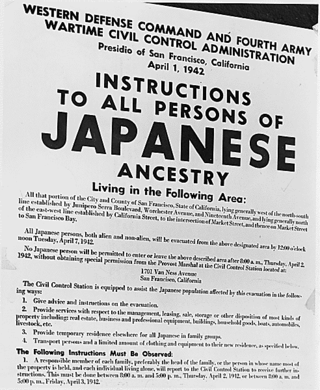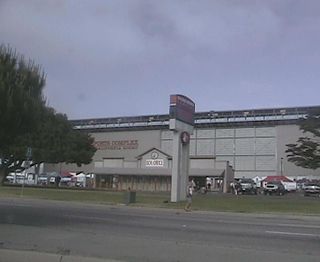
Executive Order 9066 was a United States presidential executive order signed and issued during World War II by United States president Franklin D. Roosevelt on February 19, 1942. "This order authorized the forced removal of all persons deemed a threat to national security from the West Coast to "relocation centers" further inland—resulting in the incarceration of Japanese Americans." Two-thirds of them were U.S. citizens, born and raised in the United States.

During World War II, the United States forcibly relocated and incarcerated at least 125,284 people of Japanese descent in 75 identified incarceration sites. Most lived on the Pacific Coast, in concentration camps in the western interior of the country. Approximately two-thirds of the inmates were United States citizens. These actions were initiated by President Franklin D. Roosevelt via Executive Order 9066 following Imperial Japan's attack on Pearl Harbor.

Camp Harmony is the unofficial euphemistic name of the Puyallup Assembly Center, a temporary facility within the system of internment camps set up for Japanese Americans during World War II. Approximately 7,390 Americans of Japanese descent from Western Washington and Alaska were sent to the camp before being transferred to the War Relocation Authority camps at Minidoka, Idaho, Tule Lake, California and Heart Mountain, Wyoming.

The Fairplex has been the home of the L.A. County Fair since 1922. Known prior to 1984 as the Los Angeles County Fairgrounds, it is located in the city of Pomona, California. The L.A. County Fair is held during the month of May since 2022, but the facility is used year-round to host a variety of educational, commercial, and entertainment such as trade and consumer shows, conventions, and sporting events.

The Poston Internment Camp, located in Yuma County in southwestern Arizona, was the largest of the 10 American concentration camps operated by the War Relocation Authority during World War II.

The Salinas Sports Complex is a sporting complex located in Salinas, California on the Central Coast. The main feature of the complex is a 17,000-seat stadium for California Rodeo Salinas. Soccer, football, and rugby was also played at the main stadium before the opening of Rabobank Stadium next door.

Fort Stanton was a United States Army fort near Lincoln, New Mexico.

Internment of German resident aliens and German-American citizens occurred in the United States during the periods of World War I and World War II. During World War II, the legal basis for this detention was under Presidential Proclamation 2526, made by President Franklin Delano Roosevelt under the authority of the Alien Enemies Act.
Violet Kazue de Cristoforo was a Japanese American poet, composer and translator of haiku. Her haiku reflected the time that she and her family spent in detention in Japanese internment camps during World War II. She wrote more than a dozen books of poetry during her lifetime. Her best known works are Poetic Reflections of the Tule Lake Internment Camp, 1944, which was written nearly 50 years after her detention and May Sky: There Is Always Tomorrow; An Anthology of Japanese American Concentration Camp Kaiko Haiku, for which she was the editor.

Propaganda for Japanese-American internment is a form of propaganda created between 1941 and 1944 within the United States that focused on the relocation of Japanese Americans from the West Coast to internment camps during World War II. Several types of media were used to reach the American people such as motion pictures and newspaper articles. The significance of this propaganda was to project the relocation of Japanese Americans as matter of national security, although according to a federal commission created by President Jimmy Carter in 1980:
The promulgation of Executive Order 9066 was not justified by military necessity, and the decisions that followed from it – detention, ending detention and ending exclusion – were not driven by analysis of military conditions. The broad historical causes which shaped these decisions were race prejudice, war hysteria and a failure of political leadership.

Arboga is an unincorporated community in Yuba County, California. It is located 3 miles (4.8 km), south of Olivehurst on the Sacramento Northern Railroad, at an elevation of 56 feet. It was named in 1911 by the pastor of the Mission Covenant Church of Sweden for his hometown of Arboga, Sweden.

Crystal City Internment Camp, located near Crystal City, Texas, was a place of confinement for people of Japanese, German, and Italian descent during World War II, and has been variously described as a detention facility or a concentration camp. The camp, which was originally designed to hold 3,500 people, opened in December 1943 and was officially closed on February 11, 1948.

The history of Arizona during World War II begins in 1940, when the United States government began constructing military bases within the state in preparation for war. Arizona's contribution to the Allied war effort was significant both in terms of manpower and facilities supported in the state. Prisoner of war camps were operated at Camp Florence and Papago Park, and there was an internment camp to house Japanese-Americans, most of them citizens, who had been forcibly deported from the West Coast.

The Tanforan Assembly Center was created to temporarily detain nearly 8,000 Japanese Americans, mostly from the San Francisco Bay Area, under the auspices of Executive Order 9066. After the order was signed in February 1942, the Wartime Civil Control Administration acquired Tanforan Racetrack on April 4 for use as a temporary assembly center; plans called for the site to be used to accommodate up to 10,000 "evacuees" while permanent relocation sites were being prepared further inland. The Tanforan Assembly Center began operation in late April 1942, the first stop for thousands who were forced to relocate and undergo internment during World War II. The majority were U.S. citizens of Japanese ancestry who were born in the United States. Tanforan Assembly Center was operated for slightly less than six months; most detainees at Tanforan were transferred to the Topaz War Relocation Center in Utah, starting in September. The transfer to Topaz was completed by mid-October, and the site was turned over to the Army a few weeks later.
Daisho Tana was a Buddhist missionary, leader of the Palo Alto Buddhist Temple and is best known for his detailed diaries kept during his internment in both California and New Mexico. Husband to Tomoe Tana, a well renowned tanka poet, the couple had three children, Shibun Tana, Yasuto Tana, and Akira Tana.
The United States government has detained or interned immigrants on military bases on several occasions, including as part of internment of Japanese Americans, of Italian Americans and of German Americans during World War II. In the 2010s, military bases have been used to house unaccompanied asylum seekers from Central America.

The Temporary Detention Camp for Japanese Americans / Pomona Assembly Center is one of the places Japanese Americans were held during World War II. The Pomona Assembly Center was designated a California Historic Landmark on May 13, 1980. The Pomona Assembly Center is located in what is now called the Fairplex in Pomona, California in Los Angeles County. The Pomona Assembly Center was called Los Angeles County Fairgrounds in 1942.

The Temporary Detention Camp for Japanese Americans / Santa Anita Assembly Center is one of the places Japanese Americans were held during World War II. The Santa Anita Assembly Center was designated a California Historic Landmark (No.934.07) on May 13, 1980. The Santa Anita Assembly Center is located in what is now the Santa Anita Racetrack in Arcadia, California in Los Angeles County.
The Merced Assembly Center, located in Merced, California, was one of sixteen temporary assembly centers hastily constructed in the wake of Executive Order 9066 to incarcerate those of Japanese ancestry beginning in the spring of 1942, following the attack on Pearl Harbor and prior to the construction of more permanent concentration camps to house those forcibly removed from the West Coast. The Merced Assembly Center was located at the Merced County Fairgrounds and operated for 133 days, from May 6, 1942 to September 15, 1942, with a peak population of 4,508. 4,669 Japanese Americans were ultimately incarcerated at the Merced Assembly Center.




















